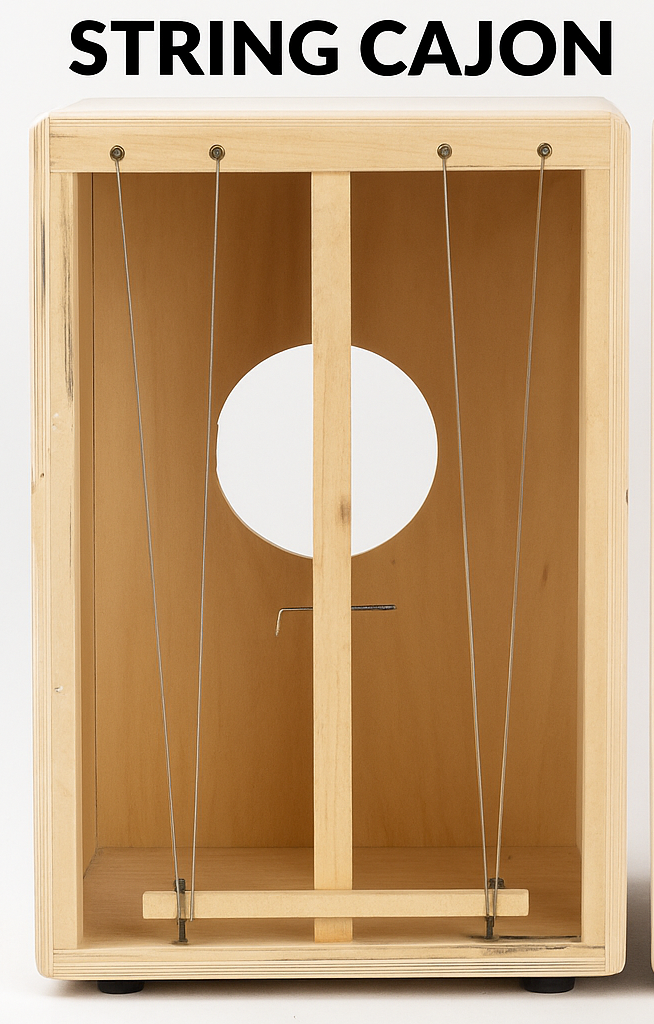Posted by Stephen Head on 12th Nov 2025
String Cajon vs Snare Cajon: The Truth About Buzz, Snap, and Control
One of the first choices a cajon player faces is whether to use a string or snare system.
At first glance, it seems simple — wires versus guitar strings. But the difference changes how the instrument reacts and how it feels to play.
At Kopf Percussion, my current designs use snare-based systems because they provide the clarity, control, and stability most players want. Both designs have advantages, and understanding them helps you decide which one fits your playing style.
1. The Traditional Design — The String Cajon
String cajons use thin guitar strings stretched against the inside of the tapa. When the face is struck, those strings vibrate and produce a sharp, sensitive tone often associated with flamenco.

Pros:
• Bright, clear top-end response
• Sensitive to light touch and ghost notes
• Easy to adjust with tension bolts
Cons:
• Needs occasional retuning
• Slightly less low-end focus depending on setup
String systems are responsive and open. They react quickly to small changes in touch and suit players who prefer a lively, expressive sound.
2. The Modern Voice — The Snare Cajon
Snare-style cajons use coiled snare wires pressed against the tapa. The result is a crisp, short buzz with a focused tone.
Pros:
• Strong attack and projection
• Clear separation between bass and slap
• Little to no maintenance once set up
Cons:
• Slightly less shimmer on very soft dynamics

Every cajon I build at Kopf Percussion uses a snare system tuned for even response across the face. The goal is a clean, balanced sound that performs the same way every time you sit down to play. That is why my American Tonewood Series uses snare systems. They are clear, controlled and consistant.
3. Control and Feel
The main difference between the two systems is how they respond.
String cajons have a looser, more open feel and react strongly to small changes in tension or touch. Snare cajons are more controlled and consistent. Once set, they stay that way.
Neither is better. It’s a matter of preference — some players want sensitivity, others want precision.
4. Listening With Your Hands
You can easily tell which system a cajon uses.
Lay your hand flat and slide your fingers upward as you tap lightly.
If the sound spreads and sustains, it’s a string system.
If it pops quickly and settles fast, it’s a snare system.
Both are useful tools — it just depends on the sound you prefer.
5. Maintenance and Longevity
String systems need regular attention. Over time, strings stretch and may require retightening to keep tension even across the face.
Snare systems, on the other hand, rarely need adjustment once they’re properly seated. They should be left alone unless a replacement is necessary.
Both systems will eventually wear out, but not at the same rate. Strings typically need replacement more often. A well-built snare setup can last for many years before showing signs of fatigue.
Closing Thoughts
Choosing between a string and snare cajon comes down to taste and playing style.
Strings provide a loose, expressive feel. Snares deliver a tighter, more defined response.
At Kopf Percussion, I currently build with snare systems because they provide consistent tone and control for most professional situations. Still, string systems have their own strengths, and I respect what they offer to players who prefer that sound.
Both designs work when they’re built well and maintained properly. The key is finding the one that fits how you play.
The choice between snares and strings helps to shape the sound of the cajon but there are other things that do as well. I go into more detail about how different wood types affect tone and resonance in Cajon Wood Types: How Different Woods Shape the Sound

